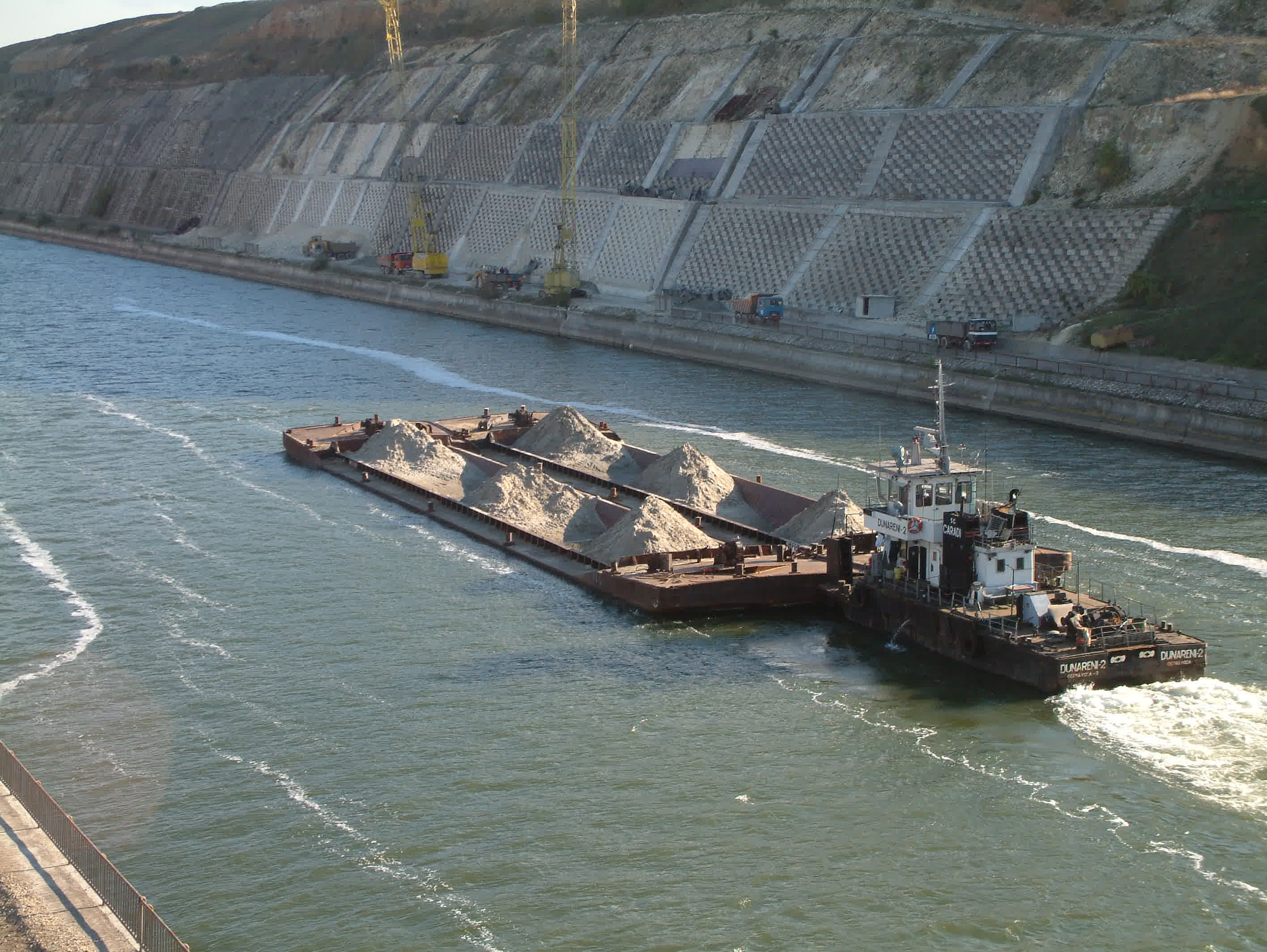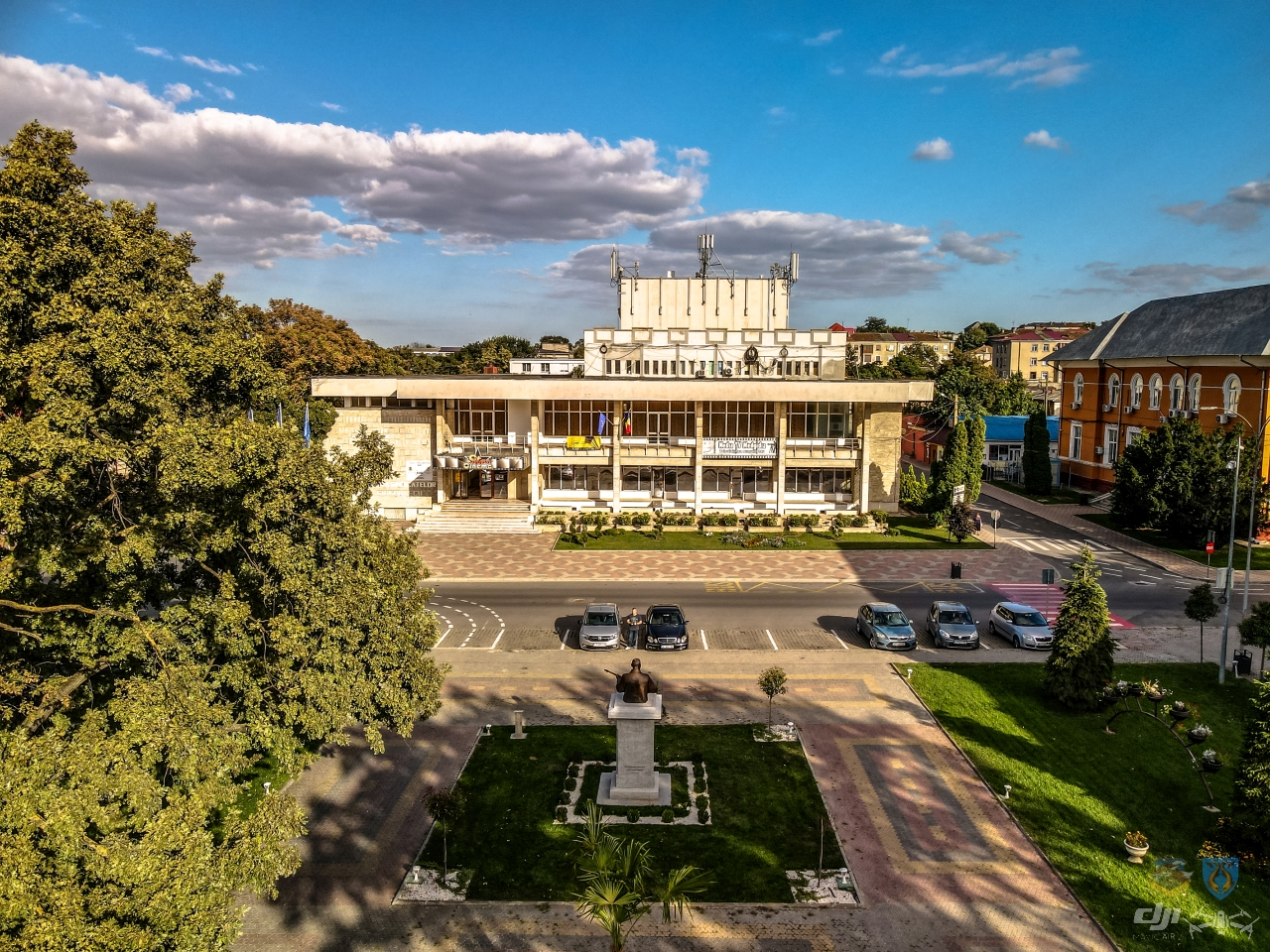|
Danube–Black Sea Canal
The Danube–Black Sea Canal () is a navigable canal in Romania, which runs from Cernavodă on the Danube river, via two branches, to Constanța and Năvodari on the Black Sea. Administered from Agigea, it is an important part of the waterway link between the North Sea and the Black Sea via the Rhine–Main–Danube Canal. The main branch of the canal, with a length of , which connects the Port of Cernavodă with the Port of Constanța, was built in 1976–1984, while the northern branch, known as the Poarta Albă–Midia Năvodari Canal, with a length of , connecting Poarta Albă and the Port of Midia, was built between 1983 and 1987. Although the idea of building a navigable canal between the Danube and the Black Sea is old, the first concrete attempt was made between 1949 and 1953, when the Socialist Republic of Romania, communist authorities of the time used this opportunity to eliminate political opponents, so the canal became notorious as the site of labor camps, when at an ... [...More Info...] [...Related Items...] OR: [Wikipedia] [Google] [Baidu] |
Constanța County
Constanța () is a Counties of Romania, county (județ) of Romania on the Bulgaria–Romania border, border with Bulgaria, in the Dobruja region. Its capital city is also named Constanța. Demographics In 2021, it had a population of 655,997 and the population density was 92/km2. The degree of urbanization is much higher (about 75%) than the Romanian average. In recent years the population trend is: The majority of the population are Romanian Orthodox Church, Orthodox Romanians. There are important communities of Muslim Turkish people, Turks and Tatars of Romania, Tatars, remnants of the time of Ottoman Empire, Ottoman rule. Currently the region is the centre of the Islam in Romania, Muslim minority in Romania. A great number of Aromanians have migrated to Dobruja in the last century, and they consider themselves a cultural minority rather than an ethnic minority. There are also Romani people, Romani. Geography *Călărași County and Ialomița County are to the west. *T ... [...More Info...] [...Related Items...] OR: [Wikipedia] [Google] [Baidu] |
Political Prisoner
A political prisoner is someone imprisoned for their political activity. The political offense is not always the official reason for the prisoner's detention. There is no internationally recognized legal definition of the concept, although numerous similar definitions have been proposed by various organizations and scholars, and there is a general consensus among scholars that "individuals have been sanctioned by legal systems and imprisoned by political regimes not for their violation of codified laws but for their thoughts and ideas that have fundamentally challenged existing power relations". The status of a political prisoner is generally awarded to individuals based on the declarations of non-governmental organizations like Amnesty International, on a case-by-case basis. While such statuses are often widely recognized by the international public, they are often rejected by individual governments accused of holding political prisoners, which tend to deny any bias in thei ... [...More Info...] [...Related Items...] OR: [Wikipedia] [Google] [Baidu] |
Ovidiu
Ovidiu (, historical name: ''Canara'', ) is a town situated a few kilometres north of Constanța in Constanța County, Northern Dobruja, Romania. Ovidiu is quite small, with a population of 13,968 as of 2021, and many wealthy inhabitants of Constanța retire there. It officially became a town in 1989, as a result of the Romanian rural systematization program. In 1930, the town was renamed ''Ovidiu'' after the Roman poet Ovid (). He was supposedly buried on a nearby small island (also called ''Ovidiu'') in the Siutghiol Lake. Administration The town of Ovidiu administers the villages of Poiana (historical names: ''Cocoșul'' - until 1964, - until 1926) and Culmea. The latter was established in 2011 by legally separating from Ovidiu two territorially distinct communities, Social Group Culmea and Social Group Nazarcea. Sport The stadium of FCV Farul Constanța is located in Ovidiu. Demographics At the 2021 census Ovidiu had a population of 13,968 with a majority of Romanian ... [...More Info...] [...Related Items...] OR: [Wikipedia] [Google] [Baidu] |
Lumina, Constanța
Lumina (Romanian for "the light") is a commune in Constanța County, Northern Dobruja, Romania. The commune includes three villages: * Lumina (historical names: ''Valea Neagră'' (until 1965); ''Cogealia'', ''Kogea-Ali'' (until 1929) - , ) * Oituz - established in 1926, named after Oituz (Bacău County) * Sibioara (historical name: ''Cicrâcci'', ) Demographics At the 2021 census Lumina had a population of 10,770 with a majority of Romanians (72.31%) and minorities of Tatars (2.35%), Roma (2.27%), Turks (0.24%), Lipovans (0.11%), Germans (0.05%), Bulgarians (0.03%), others (0.27%) and unknown (22.37%). At the 2011 census, Lumina had 7,619 Romanians (93.82%), 104 Roma (1.28%), 95 Turks (1.17%), 282 Tatars (3.47%), 4 Aromanians (0.05%), 17 others (0.21%). A large community of Csángó Hungarians Hungarians, also known as Magyars, are an Ethnicity, ethnic group native to Hungary (), who share a common Culture of Hungary, culture, Hungarian language, language and History ... [...More Info...] [...Related Items...] OR: [Wikipedia] [Google] [Baidu] |
Cumpăna
Cumpăna is a Commune in Romania, commune in Constanța County, Northern Dobruja, Romania. Administration The commune includes the village with the same name, Cumpăna (historical name: Hașiduluc, ). The village was mentioned under the name ''Hașiduluc'' for the first time in 1870 by Ion Ionescu de la Brad in his work "''Excursion agricole dans la plaine de la Dobroudja''". It was renamed to ''Cumpăna'' in 1926. Although still mentioned in the official documents as part of the Cumpăna commune, the village of Straja (historical name: ''Mahometcea'', ) was abandoned to make way for the Danube-Black Sea Canal and its population moved to Cumpăna. Cumpăna Village HallHistory of the Cumpăna commune accessed on February 22, 2012 Demographics At the 2021 Romanian census, 2021 census Cumpăna had a population of 14,757 with a majority of Romanians (81.89%) and minorities of Turks of Romania, Turks (2.57%), Romani people in Romania, Roma (2.17%), Tatars in Romania, Tatars (1%), Lipo ... [...More Info...] [...Related Items...] OR: [Wikipedia] [Google] [Baidu] |
Murfatlar
Murfatlar () is a town in Constanța County, Northern Dobruja, Romania. It officially became a town in 1989, as a result of the Romanian rural systematization program. Etymology The name of the town originates from the Turkish word of Arabic origin ''murvet'' (meaning "generous man"). Between 1921 and 1965, and from 1975 to 2007, the locality was known as ''Basarabi''. On June 26, 2007 the lower house of Romania's Parliament, the Chamber of Deputies, approved a proposal to have the name changed back to Murfatlar, which was also ratified by the Senate and promulgated by the president of Romania on December 20, 2007. Administration Murfatlar is a port on the Danube–Black Sea Canal and has a population of 9, 173 as of 2021. A complex of caves was found carved in the hills nearby, see the Basarabi Cave Complex. The village of Siminoc (historical name: ''Turc-Murfat'') is administered by the town of Murfatlar. The name of the village comes from the flower Helichrysum arenarium ... [...More Info...] [...Related Items...] OR: [Wikipedia] [Google] [Baidu] |
Medgidia (river)
The Medgidia (also: ''Valea Medgidiei'') is a small river in Constanța County, Romania. It discharges into the Danube–Black Sea Canal The Danube–Black Sea Canal () is a navigable canal in Romania, which runs from Cernavodă on the Danube river, via two branches, to Constanța and Năvodari on the Black Sea. Administered from Agigea, it is an important part of the waterway li ... in Remus Opreanu. Its length is and its basin size is . References Rivers of Constanța County Rivers of Romania {{Constanța-river-stub ... [...More Info...] [...Related Items...] OR: [Wikipedia] [Google] [Baidu] |
Nisipari (river)
The Nisipari is a small river in Constanța County, Romania. It discharges into the Danube–Black Sea Canal The Danube–Black Sea Canal () is a navigable canal in Romania, which runs from Cernavodă on the Danube river, via two branches, to Constanța and Năvodari on the Black Sea. Administered from Agigea, it is an important part of the waterway li ... near the village Nisipari. Its length is and its basin size is . References Rivers of Constanța County Rivers of Romania {{Constanța-river-stub ... [...More Info...] [...Related Items...] OR: [Wikipedia] [Google] [Baidu] |
Agi Cabul
The Agi Cabul is a river in Constanța County, Romania. It flows into the Danube–Black Sea Canal in Medgidia Medgidia ( or ; historical Turkish names: ''Karasu'' or ''Carasu'', ''Mecidiye'' or ''Megidie'') is a city in Constanța County, Northern Dobruja, south-eastern Romania. History Archaeological findings show that Dobruja was inhabited since the .... It is long, with a drainage basin of . References Rivers of Constanța County Rivers of Romania {{Constanța-river-stub ... [...More Info...] [...Related Items...] OR: [Wikipedia] [Google] [Baidu] |
Castelu
Castelu is a commune in Constanța County, Northern Dobruja, Romania. The commune includes two villages: * Castelu (historical name: ''Chiostel'', ) * Nisipari (historical name: ''Caratai'', , ) Castelu is located in the central part of the county, along the Danube–Black Sea Canal. Demographics At the 2011 census, Castelu had 3,453 Romanians (77.08%), 340 Roma (7.59%), 509 Turks (11.36%), 165 Tatars (3.68%), 6 Aromanians (0.13%), 7 others (0.16%). Gallery File:ScytianBowl.JPG, Scythian The Scythians ( or ) or Scyths (, but note Scytho- () in composition) and sometimes also referred to as the Pontic Scythians, were an ancient Eastern Iranian equestrian nomadic people who had migrated during the 9th to 8th centuries BC fr ... bowl, 5th century BC, found at Castelu. In display at the Museum of National History in Constanța References Communes in Constanța County Localities in Northern Dobruja {{Constanța-geo-stub ... [...More Info...] [...Related Items...] OR: [Wikipedia] [Google] [Baidu] |
Medgidia
Medgidia ( or ; historical Turkish names: ''Karasu'' or ''Carasu'', ''Mecidiye'' or ''Megidie'') is a city in Constanța County, Northern Dobruja, south-eastern Romania. History Archaeological findings show that Dobruja was inhabited since the Neolithic period. Starting with 46 BC the region was administered by the Roman Empire. A castrum was built in the Carasu Valley, becoming the cradle of the settlement. In 1417, the Turks invaded Dobruja. From the 15th century onwards, the region started to be colonized with a Muslim population. The settlement named "Karasu" (Turkish for "Black Water") was mentioned on the map of Iehuda ben Zara in 1497, in the notes of Paolo Giorgio (1590) and Evliya Çelebi (1653). Modern Medgidia was built by the Ottoman administration on the place of the old Karasu beginning with 1856. It was built as a planned city to accommodate refugees from the Crimean War and to serve as an economic hub for the central zone of Dobruja. The town was named in hon ... [...More Info...] [...Related Items...] OR: [Wikipedia] [Google] [Baidu] |
Mircea Vodă, Constanța
Mircea Vodă is a commune in Constanța County, Northern Dobruja, Romania. It is located in the central part of the county, along the Danube–Black Sea Canal. Demographics At the 2011 census, Mircea Vodă had a population of 4,886; of those, 4,727 were Romanians (99.24%), 28 Roma (0.59%), 6 Turks (0.13%), and 2 others (0.04%). At the 2021 census, there were 4,907 inhabitants, of which 90.46% were Romanians and 1.75% Roma. History Settlement in the area dates back at least to the time of the Roman Empire. In a place that the local Turks called "Acşandemir Tabiasi", a 10th-century castrum was found, which has a stone vallum. A Slavic inscription found in this place mentions a certain "Jupan Dimitrie" and the year 943.''Dicţionar de istorie veche a României'', Editura Științifică și Enciclopedică (1976) Villages The following villages belong to the commune: * Mircea Vodă (historical name: ''Celebichioi'' or ''Celibichioi'', ) - named after Mircea I of Wallachia * Ghergh ... [...More Info...] [...Related Items...] OR: [Wikipedia] [Google] [Baidu] |



